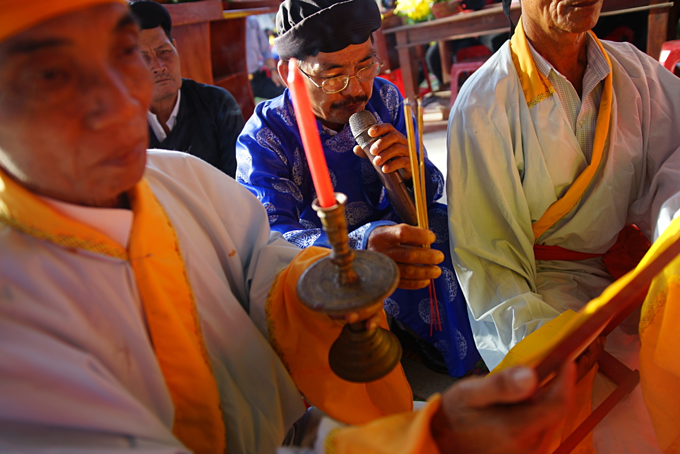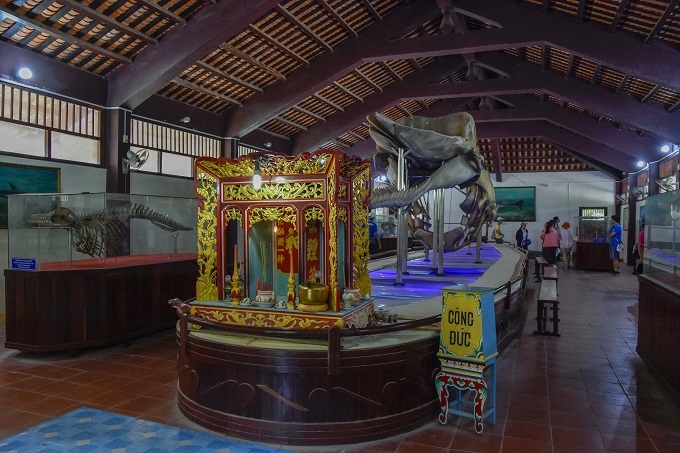
Trần Sáu was fishing 50 nautical miles from shore one day when he noticed a giant whale corpse floating in the water.
It was probably 14 meters long and weighed 15 tons, and towing it to land would be a challenge, but Sáu and the other fishermen decided to do it anyway. It took them nearly seven hours to bring it to Mui Ne in Phan Thiet town on the south-central coast.
Locals organized a funeral for the animal, placed it in a shroud and buried it with respect. After a period of time the bones will be dug up, carefully cleaned and placed in a temple for worshiping.
Why these solemn rituals for a dead animal? To fishermen in Vietnam, especially on the central and southern coasts, the whale is not just any animal; it is worshiped as Ca Ong, or "Lord Whale", who protects them at sea. Ca Ong is a deity who helps them overcome all hazards at sea, and so fishermen pray to the whale for a safe trip every time they go fishing. This is a practice that has been in vogue for generations.
Many fishermen tell stories about how they were rescued by a whale when they were in trouble at sea.
On Ly Son Island in the central province of Quang Ngai, people still recall the incredible tale of Nguyễn Công and 11 other fishermen who were caught in a storm in 2009.
Công and his men were headed home with their catch when the wind started blowing fiercely. Their engine suddenly failed and the ship was tossed about by the strong waves.
"In that moment of danger he suddenly appeared with a spout of water shooting up in the air," Công recalls.
The animal then used its back as a fulcrum for the vessel to maintain its balance all the way until it reach Ly Son Island. By then its back was abraded and bleeding. After bringing the fishermen safely to shore the whale swam around in a circle once and then turned to return to the sea.
Nguyễn Quốc Chinh also of Ly Son Island cannot count the number of fishermen who have been rescued by whales in storms. The chairman of the An Hai Ward Fisheries Union was himself an eyewitness to the legend of the whale.
On a day in May 1991 Chinh and 20 others were fishing near the Paracel Islands when a fierce storm started blowing. There were huge waves and the boat was flooded and about to sink when a whale suddenly appeared like a giant black rock.
"We lay on the back of the fish or many days, ate seaweed and drank each other’s urine to survive," Chinh says.
Finally they were spotted by a Vietnamese ship and brought to shore.
On the island, people worship whales at dozens of temples where their skeletons are preserved, burning incense and making offerings before going out to sea. The Tan Temple has parts of the skeletons of a 21-meter gray whale and a 17-meter humpback whale.
People visit the whale temples during New Year and offer trays of food to the deity and pray for a good new year, Nguyễn Điệt, the keeper of one of the temples on the island, said.

In many places around the country, fishermen celebrate Cau Ngu with fun and games and pray to the whale for a new year full of luck and bountiful harvests before setting off for the year’s first fishing trip.
While being rescued by a whale does appear supernatural and gratitude for being saved is a good enough reason to venerate the animals, there are also other explanations for this tradition.
Whale worship tradition is believed to come from the Cham people who used to live in south-central Vietnam, according to Nguyễn Duy Thiệu, a cultural expert. In a 2011 article in the Journal of Culture Heritage, he wrote that the Cham people believed the whale was a representative of the god of the sea, who protected people and ships in danger.
Thiệu also mentioned that the ritual was believed to have its origin in a Buddhist legend. When Avalokitesvara Bodhisattva once visited a coastal area and witnessed the plight of people caught in storms, she tore her cassock into many pieces and turned them into whales to help fishermen in danger. She also taught people chants to seek help from whales when in need.

There is also a legend that whales were conferred the title of Nam Hai Tuong Quan (General of the South Sea) by King Gia Long of the Nguyen Dynasty after one saved the king from an accident at sea, and subsequently people began to build temples to worship them.
Whale worship is now recognized as an important cultural heritage, especially of people living in coastal areas.
In February the whale worship celebration in Da Nang City was recognized as a national intangible culture heritage. Other whale veneration festivals elsewhere have also been listed as national intangible heritages, including in the central provinces of Phu Yen and Quang Binh.
The temples for worshiping whales have also been honored.
The Tan Temple on Ly Son Island, for instance, has been recognized as a historical-cultural relic of the nation.
Nguyễn Đăng Vũ, director of the Quang Ngai Province Department of Culture, Sports and Tourism, said: "The bunch of temples can be considered unique museums for whale bones."
Source: e.vnexpress.net(Ngoc Dinh)



